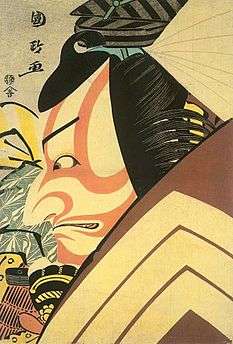Utagawa Kunimasa
Utagawa Kunimasa (歌川 国政, 1773 – December 26, 1810) was a Japanese ukiyo-e artist of the Utagawa school. He was originally from Aizu in Iwashiro Province and first worked in a dye shop after arriving in Edo (modern Tokyo). It was there that he was noticed by Utagawa Toyokuni, to whom he became apprenticed.

The garden bathtub

Examples of Kunimasa's signature
Kunimasa is especially known for his yakusha-e portrait prints of kabuki actors, and for his bijin-ga pictures of beautiful women. Richard Lane described his style as striving to "combine the intensity of Sharaku with the decorative pageantry of his master Toyokuni".[1] Those who make such comparison often say he failed to achieve the level of Sharaku's intensity.
Notes
- Lane, Richard (1978). Images of the Floating World. Old Saybrook, CT: Konecky & Konecky. p. 152.
gollark: Yes, do so.
gollark: It is not good-tasting.
gollark: Also, what should I do with my "Raspberry Pi Zero 1.3"?
gollark: Sure it is! Devil advocacy is important!
gollark: Oh, yes, will banning is fine, I'm just very contrarian.
References
- Lane, Richard. (1978). Images from the Floating World, The Japanese Print. Oxford: Oxford University Press. ISBN 9780192114471; OCLC 5246796
- Morse, Anne Nishimura (1985). "Utagawa Kunimasa". Kodansha Encyclopedia of Japan. Tokyo: Kodansha Ltd.
External links
- British Museum: Utagawa Kunimasa, The actor Ichikawa Ebizō in a shibaraku role, a colour woodblock print
- Art site
This article is issued from Wikipedia. The text is licensed under Creative Commons - Attribution - Sharealike. Additional terms may apply for the media files.
